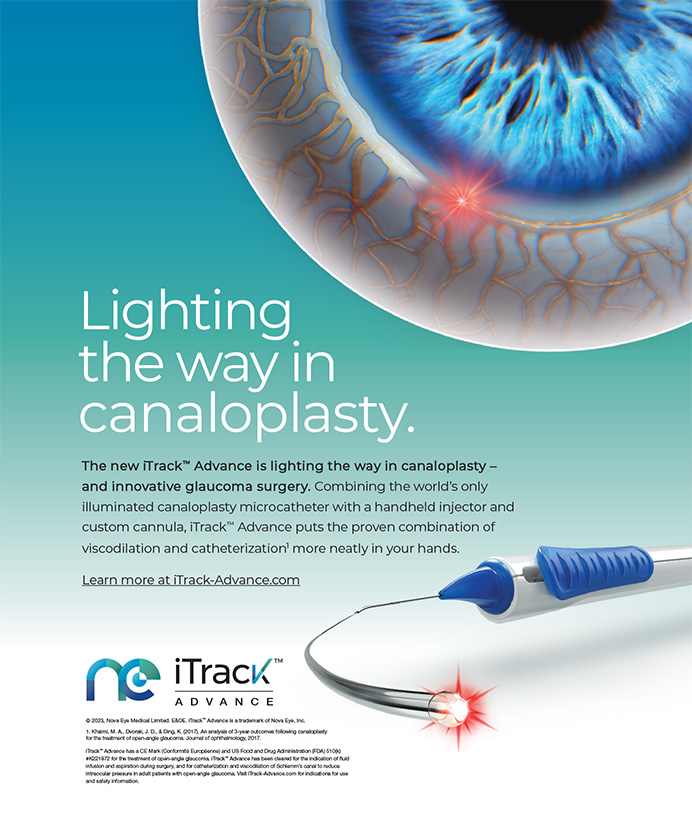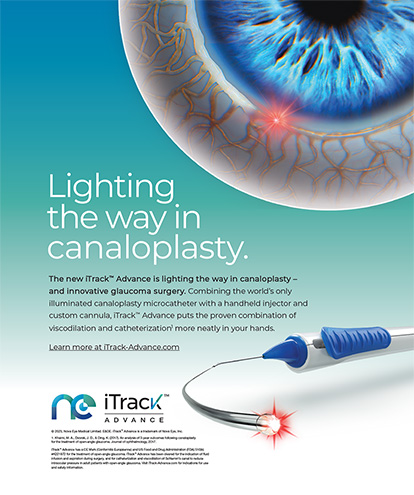A 58-year-old man sustained severe blunt trauma at the age of 16. He was referred for the evaluation of a visually
significant posterior subcapsular cataract, iridodialysis, and almost 4.00 D of corneal astigmatism (Figures 1-3).
How would you address these issues?
—Topic prepared by Alan N. Carlson, MD.
Alan S. Crandall, MD
I would plan on using iris hooks to keep the iris from interfering with phacoemulsification, so I would create two extra paracenteses. If the astigmatism were regular, I would implant a toric IOL. If the astigmatism were irregular, I would not address it initially. Given the amount of trauma to the eye, my primary concern would be zonular weakness, and I would plan to use a capsular tension ring (CTR). After performing cataract surgery with a low-flow technique, I would administer a miotic agent to reduce the pupil's size as much as possible and then place a 10–0 Prolene suture on a double-armed STC-6 needle (both from Ethicon, Inc.). To ensure that I engaged the edge of the torn iris, I would use micrograspers to hold the iris and to avoid the anterior capsule.
Next, I could either create a fornix-based peritomy or use Hoffman pockets and place the STC-6 needle where the iris' root should be, which is approximately 1 to 1.5 mm posterior to the limbus. The advantage of Hoffman pockets is that the knot is already buried, but the peritomy would be technically easier. I would probably use Hoffman pockets to save the conjunctiva in case a glaucoma procedure were needed later. I would likely need three double-armed sutures.
Because the iris in the area of the dialysis will not function, it is possible that some form of pupilloplasty may be needed. It might not be necessary, however, because the iris is superior and under the eyelid. Less surgery is often a better option, and I would avoid the pupilloplasty unless it were obviously required.
Uday Devgan, MD
Although this patient suffers from issues related to the traumatic damage to the iris he sustained 40 years ago, he is fortunate that we ophthalmologists have the ability to remove his cataract, neutralize his astigmatism, and repair his iris all at once. The preoperative photographs show that the patient has about 4 clock hours (120º) of iridodialysis with no zonular dialysis. The surgeon must protect this section of the iris during cataract surgery by using two iris hooks to suspend the iris tissue and expand the pupil. A relatively routine cataract surgery can then be carefully performed with a well-formed 5-mm capsulorhexis to hold the IOL securely in place. Cataract patients with 4.00 D of regular, stable, symmetric corneal astigmatism are perfect candidates for a toric IOL, particularly the AcrySof IQ Toric IOL (SN6AT9; Alcon Laboratories, Inc.), which can address the full extent of this patient's corneal astigmatism.
Once the new IOL was securely positioned in the capsular bag and rotated to the appropriate meridian, I would address the iridodialysis. Using a 10–0 Prolene suture on a long needle, I would place mattress sutures to reattach the iris. I would bring the ends of the sutures through a Hoffman pocket and securely tie and rotate them. A total of three sutures, one placed every 30º, would likely be needed. This would restore a nearly normal shape to the pupil, close the peripheral iris defect, and achieve a pleasing cosmetic result (Figure 4). With the iris repaired, the astigmatism neutralized, and the cataract addressed, this patient should recover excellent vision.
Howard V. Gimbel, MD, MPH
I would start with a large fornix-based conjunctival flap and fashion three Hoffman tunnels in the zone of the iridodialysis 1 mm away from the limbus to avoid inducing astigmatism. I would make the middle Hoffman tunnel longer than the others for the possible placement of a Cionni Ring for Sclera Fixation (Morcher GmbH, distributed in the United States by FCI Ophthalmics, Inc.). I would create two limbal paracenteses for iris hooks to hold the torn iris back during the cataract surgery. Next, I would place a paracentesis at the 10-o'clock position, instill nonpreserved 1% lidocaine and a dispersive viscoelastic, and insert iris hooks through the two preplaced limbal paracenteses to round out the pupil. Even if the presence of zonular weakness demanded a regular CTR or a Cionni Ring, I would use a slow-motion phaco technique and implant a toric IOL. After implanting the IOL, I would constrict the iris as much as possible with acetylcholine (Miochol-E; Bausch + Lomb) and fill the anterior chamber with a cohesive viscoelastic, especially under the torn iris, to protect the capsule underneath during suturing.
I would stretch the iris dilators with microforceps to find the iris' base. Then, with three double-armed 10–0 Prolene sutures on curved needles, I would enter the anterior chamber through the temporal incision, engage the iris' base, and guide each needle out by docking through a 27-gauge needle passed through preplaced 1-mm incisions made with a diamond knife 1.5 to 2 mm from the limbus through the Hoffman tunnels. I would loop the sutures out of the tunnels and adjust the knots to achieve proper tension and as round a pupil as possible. The conjunctiva would be closed with two 10–0 Vicryl wing sutures (Ethicon, Inc.) with the knots buried. To complete the case, I would remove the viscoelastic, hydrate the wound, instill nonpreserved vancomycin (1 mg/0.1 mL of balanced salt solution) into the anterior chamber, confirm the IOP, and administer a small bolus of vancomycin under the conjunctiva superotemporally.
Mark Packer, MD, CPI
The red reflex on the slit-lamp photograph reveals a well-centered crystalline lens. The photograph also suggests that no obvious zonular dialysis has occurred. A slit-lamp examination would likely show pseudophacodonesis, missing zonular fibers, or increased distance between the anterior lens capsule and the iris if there were zonular disruption. Assuming that no contraindicative zonular issues reveal themselves during surgery, implanting a toric IOL would be the simplest method by which to correct the corneal astigmatism. A toric IOL would be contraindicated, however, if good centration and rotational stability could not be guaranteed.
Zonular weakness will generally manifest as movement of the lens when viscoelastic is injected or as wrinkling of the anterior capsule during the construction of the capsulorhexis. If the dialysis is less than 3 clock hours, with good capsular stability, a CTR might stabilize the capsule enough to permit the safe implantation of a toric IOL. Traumatic zonular dialysis is stationary (as opposed to progressive zonulopathy due to pseudoexfoliation, for example), so the status of the anterior capsule at the conclusion of surgery is likely to remain constant.
After the IOL's insertion, the iridodialysis should be repaired with 10–0 Prolene sutures. There is no need to repair the iris prior to cataract extraction, because doing so would risk damage to the capsule. The iris can be kept out of the way during phacoemulsification with viscoelastic. To repair the iris, a scleral pocket could be constructed via a peripheral, partial-thickness clear corneal incision, and long, curved, double-armed transchamber needles could be passed through the temporal phaco incision, through the peripheral iris, and then out through the scleral pocket and conjunctiva.1 A generous amount of dispersive viscoelastic should be used to protect the corneal endothelium during the needles' passage. Two sets of double-armed sutures will likely be adequate to achieve an excellent cosmetic and functional result.
Alan N. Carlson, MD
Each of the contributors discusses iris protection, zonular “awareness” from previous trauma, iridodialysis repair, and astigmatic correction with an IOL. After protecting the iris, removing the cataract, and inserting a toric IOL, I chose a somewhat less elegant approach. By making my limbal tunnel incision somewhat more posterior, I incorporated the peripheral iris through some of the sutures at the wound's inner entry site. It is important to construct the wound in a manner that does not allow gaping, iris prolapse, epithelial ingrowth, or forward “tenting” of the peripheral iris. The sutures that attach the peripheral iris must also have proper tension in order to provide long-term support for the iris and the wound's integrity. The patient achieved a UCVA of 20/25 and is most fascinated by the return of pupillary constriction to light stimulus. Although this technique worked exceptionally well for this patient, next time, I will likely try to incorporate the elegant technique initially proposed by Richard Hoffman, MD.1
Section Editor Alan N. Carlson, MD, is a professor of ophthalmology and chief, corneal and refractive surgery, at Duke Eye Center in Durham, North Carolina. Dr. Carlson may be reached at (919) 684-5769; alan.carlson@duke.edu.
Section Editor Steven Dewey, MD, is in private practice with Colorado Springs Health Partners in Colorado Springs, Colorado.
Section Editor R. Bruce Wallace III, MD, is the medical director of Wallace Eye Surgery in Alexandria, Louisiana. Dr. Wallace is also a clinical professor of ophthalmology at the Louisiana State University School of Medicine and an assistant clinical professor of ophthalmology at the Tulane School of Medicine, both located in New Orleans.
Alan S. Crandall, MD, is the John A. Moran presidential professor, the senior vice chair of ophthalmology and visual sciences, the director of glaucoma and cataract, and the codirector of the International Division for the John A. Moran Eye Center at the University of Utah in Salt Lake City. He is a consultant to Alcon Laboratories, Inc. Dr. Crandall may be reached at (801) 585-3071; alan.crandall@hsc.utah.edu.
Uday Devgan, MD, is in private practice at Devgan Eye Surgery in Los Angeles and Beverly Hills, California. He is a consultant to and speaker for Alcon Laboratories, Inc. Dr. Devgan may be reached at (800) 337-1969; devgan@gmail.com.
Howard V. Gimbel, MD, is a professor in and the chairman of the Department of Ophthalmology at Loma Linda University in Loma Linda, California, a clinical professor in the Division of Ophthalmology, Department of Surgery at the University of Calgary, and the medical director and senior surgeon at the Gimbel Eye Center in Calgary, Alberta, Canada. He acknowledged no financial interest in the products or companies he mentioned. Dr. Gimbel may be reached at (909) 558-2154 or (403) 286-3022; hvgimbel@gimbel.com.
Mark Packer, MD, CPI, is president of Mark Packer MD Consulting, Inc. He acknowledged no financial interest in the products or companies he mentioned. Dr. Packer may be reached at mark@markpackerconsulting.com.
- Hoffman RS, Fine IH, Packer M. Scleral fixation without conjunctival dissection. J Cataract Refract Surg. 2006;32:1907-1912.


